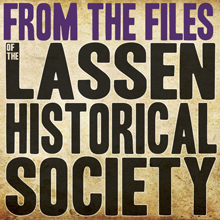
by Susan Couso
One might wonder what an English military officer, who was born in 1584 and arrived on the Mayflower, has to do with Lassen County History. But there is a connection.
In the 1890’s, a man named William Smythe promoted the idea of irrigating the West and creating fertile farmland and new thriving communities on what was, at that time, wasteland. He spoke to crowds in the Chicago area, and those listeners, who were dissatisfied with life in the area, formed the “Plymouth Society of Chicago.”
Their first experiment, using irrigation, was the town of Plymouth, Idaho, in 1896. It was a planned community, with everything thought out before the first ‘colonist’ purchased into the venture.
With success at hand, Smythe joined with other businessmen to form the Associated Colonies in New York, and preparations were made to establish a new community in the arid West.
For Smythe, this was probably an effort to prove his theories correct, but mostly, the ‘Associated Colonies’ was a business venture. They could buy land at a low price, and by showing how it could be irrigated, promote it as fertile farmland.
‘Colonists’ purchased acreage which also included a lot in the planned town. And, thus, in 1897, the town of Standish was created, as the second community using Smythe’s irrigation system plans to insure abundant water. By buying a 40-acre parcel, a person also received a one-acre lot in town. A 20-acre parcel purchase entitled them to a one-half-acre town lot.
The town of Standish, named for that courageous colonist, Miles Standish, was laid out with broad streets and several parks with names like Standish Park, Alden Park and Plymouth Park, all to evoke a sense of East Coast stability.
According to the literature promoting the ‘colony’, “The Standish Colony From the Exploits of Myles Standish In the Highlands of California”, was a fantastic opportunity using, in part, the policies established by the treatise, Brigham Young and his followers in the valleys of Utah. ‘Colonists’ when purchasing into the new town, not only paid for their land, but had to show available money to invest to improve their property and improve the town itself.
The village of Standish was to have, of course, schools, a library, hotel, and church, but also a creamery and cheese plant, a refrigerating plant, a preserving and canning plant, a pork-packing plant, a starch factory, and an evaporator. It was to have domestic water provided by Artesian wells, and piped in from Baxter or Willow Creek.
The actual irrigation system, built by Charles Hartson & sons and the Holmes brothers, first spewed water into the system in 1910, pumped by a gas engine from Honey Lake. This occasion was celebrated by much ‘hoop-la’ and plenty of speeches by local dignitaries.
Things didn’t work out as dreamed by William Smythe, but Standish did become a beautiful little farming community. Without the dreams and the hopes of Miles Standish, William Smythe, the Associated Colonies in New York, and many others, the town of Standish would not exist.








